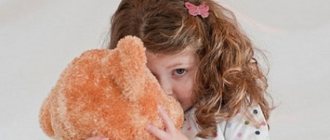- Causes of anxiety in children
- Difficulties in diagnosis
- Basic techniques
- Instructions for testing using the “Locomotive” technique as an example
The presence of disturbing conditions in children at an early age is a problem for many parents. The situation is complicated by the difficulties of identifying, assessing and interpreting the baby’s emotional state. To make the task easier, a large number of different techniques have been developed, among which gaming techniques occupy a special place. Thus, the Locomotive technique for identifying anxiety in preschoolers uses visual sampling of colors that are associated with a certain mood.
Increased anxiety in a child: signs
The second most common problem after behavioral disorders in children is increased anxiety. Its signs are found in 8% of children. And unfortunately, this figure is growing.
What is anxiety? These are episodic manifestations of fear. Each age has its own, and we’ll talk about it below. Anxiety is an absolutely normal manifestation if it is caused by specific circumstances. If it is present in the “background”, we can talk about pathology.
In other words, any child can become agitated and begin to worry if some exciting event occurs in his life, even if it is pleasant, but in ordinary life he is calm and joyful. A child with signs of increased anxiety practically cannot relax, and constantly experiences anxiety - when he is in a familiar environment, when visiting, on a holiday, in the park, when a stranger addresses him, etc.
The main difficulty in diagnosing increased anxiety in children is that while they are small, they cannot accurately tell about the problem, and closer to adolescence they can persistently deny them. Here are some signs of increased anxiety in your child that you should be wary of:
Behavioral:
- fussiness;
- motor restlessness;
- repetitive obsessive movements - finger sucking, hair curling, nail biting;
- sleep disorders;
- stiffness;
- panic fear of the new, of any change;
- diffidence;
- refusal of new activities;
- seriousness;
- reluctance to stand out and desire for silence;
- frequent fears for no reason;
- low self-esteem.
Somatic signs
(the child may not talk about them, and they may also be associated with certain diseases).
If you suspect increased anxiety in your child, you should focus on a combination of somatic and behavioral signs.
- hot flashes or chills;
- tremor or shaking;
- cardiopalmus;
- chest discomfort or pain;
- feeling of a lump in the throat;
- difficulty breathing;
- fainting or dizziness;
- muscle tension;
- numbness or tingling;
- feeling of “emptiness in the head”;
- a feeling of the unreality of objects or the separation of one’s own “I”.
American psychologists P. Baker and M. Alvord advise paying attention to whether the child’s behavior has the following signs: constant anxiety, difficulty, sometimes inability to concentrate on anything, muscle tension (for example, in the face, neck), irritability, sleep disturbance.
Basic techniques
To determine the presence of disturbing conditions in children of preschool and primary school age, a large number of various methods have been developed:
- "Ladder". The method is aimed at determining the level of self-esteem of a preschooler, how he sees the attitude of peers, parents, and adults towards him. The child’s attitude is very closely related to the disturbing conditions that haunt him. To carry out you need: a sheet of paper, cardboard, pencil, scissors. A ladder with seven steps is drawn on the sheet. The steps are the same, except for the third, which is wider. A human figure is drawn and cut out on cardboard. The child is asked to place the figurine on a specific step. The figures represent the child himself, the teacher, the educator, and other good and bad guys. The level of self-esteem is determined by the placement of the figurine on the step. The technique is used in diagnosing anxiety. It allows you to determine the impact on disturbing states of self-esteem and relationships with other people.
- Test "Fears in houses". Two houses are drawn on the sheet. The child is given a task: the “scary” and “non-scary” fears need to be distributed among the houses. Read 29 fears. The kid distributes them into houses. Based on sorting, objects that cause fear and anxiety in the child are determined.
- Choose the right person. The preschooler is asked to look at 14 pictures depicting various situations from a child’s life. The pictures show a baby with a face that is not drawn. The tested child needs to choose a “happy” or “sad” face that he associates with the situation in the picture. Based on the baby’s reaction to specific situations, the presence of anxiety and the sources of its development are determined.
- "Drawing of a Man." Materials needed: a sheet of paper and a pencil. The child is given the task of drawing a person without specifications, comments or explanations. When the figure is drawn, the child is asked who he drew. The drawing is analyzed, and the presence of anxiety in the baby is determined by the bright details.
- "Lamb in a Bottle" The technique is aimed at diagnosing the child’s psychological self-perception in the family. Materials: two sheets of paper and a pencil. On one sheet of paper, the child draws a lamb in a bottle. On the second sheet, you need to write down how the lamb feels, what he dreams about, what worries him. If the child does not know how to write, he is asked to answer these statements about the lamb. Based on the drawing and answers, the baby’s condition, the presence of anxiety, and the characteristics of its expression are determined.
- "Draw your fear." The child is asked to draw his fears on a piece of paper. After completing the task, the child is asked to comment on the drawing. Based on the drawing and answers, the objects of the child’s anxiety are determined.
- "Non-existent animal." The child is asked to draw a non-existent animal and give it a name. The child is asked to tell about the animal, what he loves, his fears and worries. Based on the drawing and answers, an idea of the disturbing conditions is formed.
- "Cactus". A test to determine the child’s emotional state, the presence of aggressiveness, and its direction. The child is asked to draw a cactus. After completing the drawing, a conversation is held with the child aimed at clarifying the details of the drawing. Based on the drawing and answers, an emotional portrait of the baby is drawn up.
- "Locomotive".
A special feature of the methods for children is their presentation in the form of manifestations that are understandable and natural for children - playing, drawing, composing a complex object from simple parts, etc.
In some cases, they are also used for teenagers.
Test for a child's anxiety level
If you notice signs of increased anxiety in your child, we recommend that you conduct a small test to clarify.
Questionnaire
Lavrentieva G. P. and Titarenko T. M.
Answer yes if you agree with the statement and no if the statement does not apply to your son or daughter:
1. Your child cannot work for a long time without getting tired 2. Has difficulty concentrating 3. Any task causes unnecessary anxiety 4. Is very tense and constrained in completing tasks 5. Is embarrassed more often than others 6. Often talks about tense situations 7. As a rule, blushes or turns pale in an unfamiliar environment 8. Complains that he has terrible dreams 9. His hands are usually cold and wet 10. Often suffers from upset bowel movements 11. Sweats a lot when he is excited 12. Does not have a good appetite 13. Has difficulty falling asleep, sleeps restlessly 14. Shy, many things cause him fear 15. Usually restless, easily upset 16. Often cannot hold back tears 17. Does not tolerate waiting well 18. Does not like to take on new things 19. Not confident in himself and his abilities 20. Afraid to face challenges difficulties
For each positive answer, count 1 point:
If the total number of points reaches 15-20 points, then your child has increased anxiety; 7-14 points—average; 1-6 points—low
Types of Anxiety
It is important for a psychologist to identify the type of anxiety in children. There is a distinction between situational anxiety – an emotional state caused by external factors. The second type is personal anxiety, a stable trait, an individual characteristic. It manifests itself as a tendency to excessive, frequent and strong experiences, anxiety due to various circumstances.
Moderate anxiety in certain situations is necessary and useful, but if it crosses rational boundaries, it is already a maladjustment reaction that disrupts the organization of behavior and the child’s activities.
Causes of anxiety in children
Most psychologists are confident that the main reason for increased anxiety in a child is the anxiety of the adults who surround him. Moreover, this is not a hereditary trait, but a feature of upbringing. Here are some parenting styles that can lead to increased anxiety in a child.
- Overprotection. Such parents strive to protect their child from any threats, including imaginary ones. As a result of such overprotection, the child feels defenseless in front of the world and inability to achieve success on his own.
- Increased requirements. These parents have either achieved little in this life and want their children to make their dreams come true, or, on the contrary, climb high up the social ladder and demand that the child meet high standards. In both cases, the personality of the little person and his true needs are ignored. The child is afraid of not living up to high expectations, of losing the love of his parents, and this creates anxiety in him
- Authoritarian style. Such parents themselves were raised in Spartan conditions, and they raise their offspring in the same way. There are only responsibilities and no feelings. The child's emotions are rejected, fears are ridiculed, dreams are devalued. This creates low self-esteem, lack of self-confidence and, as a result, increased anxiety.
Definition and explanation of a child's anxiety problem
We all experience fear from time to time - both very real and irrational, associated with our thoughts and feelings. This is one of the mechanisms for the survival of humans as a species. Children at different ages are dominated by certain fears associated with the stages of their psychological development and the acquired experience of socialization. Thus, at an early age, children are dominated by fears of pain, darkness or objects, sounds; in preschool age, the fear of death often arises; in younger schoolchildren, a typical fear is that they will lose the respect and appreciation of their parents and others. A typical fear for teenagers is loneliness, closed spaces, and crowds. But it is important to determine where ordinary fears and anxiety turn into pathology. Episodic fears and anxiety are the norm; they are always tied to specific circumstances. But the pathological level of anxiety in a child is a stable condition with clinical symptoms that is not tied to specific circumstances and real threats to life and health. That is, a child with pathological anxiety is always worried, even when there is no reason for this, he cannot relax, he is always tense.
Anxiety disorder in school-age children (7 to 10 years)
Starting from school, the social interactions of the child himself are added to the main cause of increased anxiety - unfavorable family upbringing. If he has learned from his parents that he lacks confidence in his own abilities and in himself, he may begin to worry about a possible loss of respect from peers, teachers, fear of not meeting the expectations of adults and fear of punishment, conflicts with friends if he cannot meet their demands and desires.
At the same time, girls worry more about relationships with other people, while boys are more concerned about punishment and violence.
Girls, having done an “unseemly” act, worry that the teacher or mother will think badly of them, and their friends will stop playing with them. In the same situation, boys are likely to fear that adults will punish or beat them.
What are the dangers of increased anxiety?
Excessive anxiety in children leads to overwork, decreased performance, and reduces the chances of discovering all the child’s talents. The body's resources are spent on suppressing emotions and fears, rather than on productive activities. If the problem is not solved, it can result in neuroses, depression and personality changes. In addition, full communication with others – peers and adults – suffers. Such children often become dependent on leaders and may become members of not the best companies.
Correction of anxiety in children
If you see that your child suffers from increased anxiety and want to help him, you need to remember that this is a complex work:
- Reconsider your relationship with the world; if you or your husband are anxious and distrustful of the future, it is unlikely that you will be able to rid your child of anxiety
- Change your parenting style if you recognize it in one of the above
- Perhaps you should consult a psychologist in order to work on yourself to become calmer and more confident, then the child will get rid of anxiety even without outside interference.
Important “Being unhappy people, you will never be able to build a relationship with your child so that he is happy. And if the parents are happy, then there is no need to do anything special.”
M. Labkovsky
Here are some specific techniques for helping your anxious child that will help them and teach them some ways to cope with anxious thoughts and stress:
Trick #1: Give your fear a name.
The first psychological tactic is to help defuse the child’s anxiety and work on relieving fear.
The way it works is quite simple. All you do is ask your baby to come up with a silly name for the unpleasant feelings he is experiencing. It is very important that the name is as non-threatening as possible. This will help remove seriousness and reduce fear.
Once children find a name they are happy with, the next step is to tell the emotions to go away. For example, if he decides to call his emotion "Stupid Donkey", he might say something like this:
"Leave me alone, Stupid Donkey!"
“Stupid donkey, go away, I’m tired of you!”
By giving his feelings a stupid name and talking to them out loud, he will take away the power from those emotions. And then the child will be able to calm down much faster, and what is very important, having learned this technique, he will be able to use it even when you are not around, and independently regulate his feelings.
Technique #2: Listen
When someone tells you about their problems, including our child, the first instinct is usually to help them with it immediately. However, this impulse and these feelings are not so useful when dealing with children (and often with adults too). They act less rationally than adults, and their anxieties are not as clearly expressed. Therefore, using logic to explain that everything is fine does not always work as we would like.
Trying to show or explain to a little person that nothing bad is actually happening and there is no reason to be afraid will actually increase his level of anxiety, since all he will understand is that they don’t believe him, and no one cares about his fears. His feelings and emotions still, due to his age, do not lend themselves to logic and reasonable explanations, and the fear will not go away. Instead, try to actively listen to your child while you show affection. For example, use physical contact: kissing or hugging, this will help calm his feelings. In general, if your child feels listened to, heard, protected, and the parent is available, his anxiety will disappear almost immediately and problem solving will be easier.
Trick #3: Give your child a “magic” calming object
Various studies show that it is possible to associate an object with a specific emotion. So if your little family member has a special stuffed toy or security blanket, for example, use it to your advantage and to relieve stress!
Recent research shows that sleeping with a stuffed animal helps children with night terrors. The same principle applies in many other situations of relieving any nightmare. If he's scared on the first day of school, why not let him take something with him that makes him happy? If the object is quite small, other children won't even know they have it.
This technique works even better if you choose a “defender” together; there can be several of them: one for each situation. Ask them to choose an item that will help them in times of anxiety. Thus, the child will be more involved in this process, and the effect will increase many times over.
Psychodiagnostic techniquestest on the topic
Psychodiagnostic techniques
No. 1 Identification of fears and anxiety levels in children using the anxiety test R. Thammle, M. Dorki, V. Amen
This test is based on 14 typical situations for the life of a primary school student. The purpose of testing is to identify children with genuine school anxiety. The researcher asks children to imagine their peer in a number of everyday situations (playing with younger children, child and mother with baby, object of aggression, getting dressed, playing with older children, going to bed alone, washing, reprimanding, being ignored, aggressive attack, picking up toys, isolation , child with parents, eating alone) and motivates them to respond to given situations according to their experience or what seems right to them in a given situation. Children are given sheets of paper with the text of the task and proposed situations: “Imagine your peer. What facial expression will he (she) have in the following situations, happy or sad? If it is happy, then circle +, and if it is sad, then circle -.
1.Your peer plays with younger children: + -
2. He (she) is walking with his mother and younger brother or sister: + -3. Something makes him (her) angry: + -
4. He (she) gets dressed for school in the morning: + -
5. He/she plays with older children: + —
6. He (she) goes to bed: + —
7. He (she) washes or bathes: + —
8. He (she) is reprimanded, scolded: + —
9.Parents take care of their younger brother or sister, but do not pay attention to him (her): + -
10. A book or toy is taken away from him (her): + —
11. He (she) puts away toys: + —
12. He (she) sits alone: + —
13. He (she) with his parents: + -
14. He (she) has lunch alone: + — »
Testing data is subjected to quantitative analysis, on their basis the child’s anxiety index (I.T.) is calculated, which is equal to the percentage ratio of the number of emotionally negative choices (E.N.V.) (sad face) to the total number of drawings (14). This can be represented by the following formula: I.T.=(E.N.V./14)*100%
Depending on the anxiety index, children are divided into three groups:
A) High level of anxiety (I.T. above 50%)
B) Average level of anxiety (I.T. from 20 to 50%)
C) Low level of anxiety (I.T. from 0 to 20%)
Testing data is entered into a table that allows you to clearly show the anxiety index of each child in the test group.
| FULL NAME. child | Computing I.T. | Indicator I.T. | Anxiety level |
Methodology "Locomotive" (Identification of anxiety in preschool children)
The technique allows you to determine the characteristics of the child’s emotional state: normal or low mood, states of anxiety, fear, satisfactory or low adaptation to a new or familiar social environment.
Source: Diagnosis of mental states of preschool children: Educational and methodological manual. Comp. Velieva S.V. St. Petersburg: Rech, 2005.
Aimed at determining the degree of positive (PPS) and negative (NPS) mental state. Used individually with children from 2.5 years old.
Stimulus material: a white train and 8 multi-colored carriages (red, yellow, green, blue, purple, gray, brown, black). The trailers are randomly placed on a white background.
Instructions: “Look at all the trailers. Let's build an unusual train. Place the trailer that you think is the most beautiful first. Now choose the most beautiful one from the rest, etc.”
It is necessary for the child to keep all the trailers in sight. The younger the child, the more often the instructions are repeated, and at the same time they circle the remaining trailers with their hand.
The following are recorded: the color position of the trailers; child's statements.
Data processing.
1 point is awarded if the child places the purple trailer in the second position; black, gray, brown - on the third; red, yellow, green - on the sixth.
2 points are awarded if the child placed the purple trailer in the first position; black, gray, brown - on the second; red, yellow, green - on the seventh, blue - on the eighth.
3 points are assigned if a black, gray or brown trailer is placed in the first position; blue - on the seventh; red, yellow, green - to the eighth position.
If, as a result of summing up the data obtained, the points are less than three, then the mental state is assessed as positive, with 4-6 points - as a low-degree negative mental state (LSNS); with 7 - 9 points - as an NPC of average degree; more than 9 points - high-level NPC.
Evaluation of results
4 points - positive mental state
3 points – low degree negative mental state
2 points - moderate negative mental state
1 point – high degree of negative mental state
Along with the individual result obtained, the general psychological climate in the group can also be determined. To do this, the sum of all PPP (a) and NPS (b) is determined, the difference between them is divided by the number of children and multiplied by 100%.
Evaluation of results:
70% and above - a high degree of favorable psychological climate (sBPK);
42 - 69% - average sBOD;
26 - 41.9% - insignificant sBOD;
0 - 25% - initial degree of unfavorable psychological climate (sNPC);
-1 to — 25% - average sNPK;
- 26% and below - strong sNPK.
Sociometry
Let us dwell on the description of the methodology that corresponds to the age characteristics of preschoolers 4-7 years old. “Ship Captain” During an individual conversation, the child is shown a drawing of a ship (or a toy boat) and asked the following questions: 1. If you were the captain of a ship, who from the group would you take as your assistant when you went on a long journey? 2. Who would you invite on the ship as guests? 3. Who would you never take with you on a voyage? 4. Who else remained on the shore? As a rule, such questions do not cause any particular difficulties for children. They confidently name two or three names of peers with whom they would prefer to “sail on the same ship.” Children who received the largest number of positive choices from their peers (1st and 2nd questions) can be considered “popular” in this group. Children who received negative choices (3rd and 4th questions) fall into the “ignored” group. Children's answers (their negative and positive choices) are entered into a special protocol (matrix):
| Full name | Yura K. | Borya Zh. | Inna G. | Sveta Ch. | Kolya I. |
| Yura K. | + | — | — | ||
| Borya Zh. | + | + | + | ||
| Inna G. | + | — | — | ||
| Sveta Ch. | — | ||||
| Kolya I. | — | — | — |
When analyzing the results of the methodology, an important indicator is also the reciprocity of children’s choices. The most favorable cases are considered to be cases of mutual elections. Based on the children’s answers in each of the methods, a sociogram of the group is compiled, where there are pronounced stars and outcasts.
It should be emphasized that not every group has such a clear sociometric structure. There are groups in which all children receive approximately the same number of positive choices. This indicates that the attention and friendly attitude of peers is distributed approximately equally among all members of the group. Apparently, this situation is due to the correct strategy for developing interpersonal relationships and is the most favorable. [1 p.282-286].
Two houses To carry out the technique, you need to prepare a sheet of paper on which two houses are drawn. One of them is large, beautiful, red, and the other is small, nondescript, black. The adult shows the child both pictures and says: “Look at these houses. The red house has a lot of different toys and books, but the black house has no toys. Imagine that the red house belongs to you, and you can invite everyone you want to your place. Think about which of the guys in your group you would invite to your place, and which one you would put in a black house.” After the instructions, the adult marks those children whom the child takes into his red house, and those whom he wants to place in the black house. After the end of the conversation, you can ask the children if they would like to change places with someone, if they have forgotten anyone. The interpretation of the results of this test is quite simple: the child’s likes and dislikes are directly related to the placement of peers in the red and black houses.
Tips for parents
Here are some more psychological tips for comprehensive work with anxiety and fears in children:
The basis of everything will be work in these three areas:
1. Increased self-esteem:
- Call your child by name often and maintain eye contact when speaking.
- Increase the number of tactile contacts. Affectionate touches help restore trust in the world.
- Celebrate his successes often and preferably publicly (for example, at a family dinner). Remember that there is always a reason for praise. It is enough to notice the little things that your child does better than yesterday.
- Organize parties at home and invite your classmates to them. Even your presence in another room will have a beneficial effect on an anxious child. He will feel more confident than all alone at school, and this will gradually change the opinion of his peers about him. Believe me, this is extremely important for him, even if he doesn’t admit it.
- Practice heart-to-heart conversations. This should be the time when you completely belong to the child and listen to him with all your attention, without being distracted by the phone or other family members. The time when he can tell you everything that worries and excites him. Your undivided attention will show him how important his feelings and he are to you.
- Separate the child's actions from the child himself. Don't tell him that he is bad if he got a bad mark and offended his younger sister. Discuss and condemn the act itself: “ I love you, you are very good, but now you did something wrong
»
2. Teaching a child coping methods:
- Set an example of positive expectations for the future and demonstrate confident behavior.
- Teach him the methods listed in Chapter. 6
- Discuss learning and communication difficulties with your child, and jointly develop a strategy for moving towards success.
- Teach him breathing techniques and mindfulness
3. Relieve muscle tension:
- Create rituals, for example, every Saturday we dance,
- Give your child a massage before bed - it will also strengthen your relationship
- Play sports with him - it helps relieve tension and get rid of stress, and in addition, brings him closer together.
- Hug and kiss as much as possible - children (and adults, too) need tactile contact









